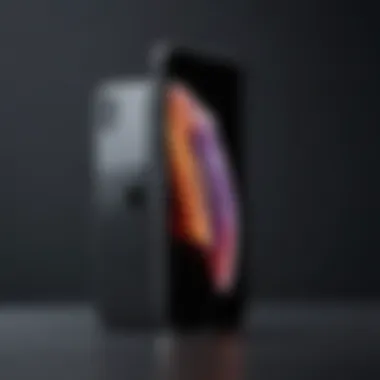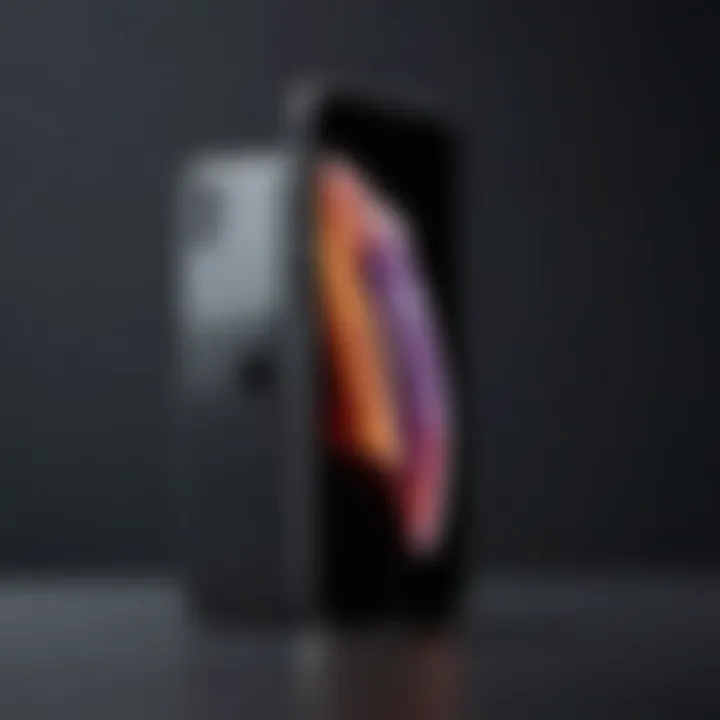Exploring the Smallest iPhone Available


Product Overview
The Apple iPhone SE (2022), often referred to as the smallest iPhone available, showcases Apple's ongoing commitment to blending compact design with powerful functionality. This model, launched in March 2022, captures user interest with its small size, making it an attractive option for those preferring devices that easily fit in the hand or pocket.
Key Features and Specifications
The iPhone SE boasts several compelling specifications:
- Display: 4.7-inch Retina HD display
- Processor: A15 Bionic chip
- Camera: 12 MP rear camera with advanced image stabilization
- Storage Options: Available in 64GB, 128GB, and 256GB variants
Apple’s choice of the A15 Bionic chip ensures that the SE delivers exceptional performance, comparable to contemporary models in a much more compact form.
Design and Aesthetics
The design echoes the classic iPhone look, featuring rounded edges, a metal frame, and glass back. The button layout includes a home button with Touch ID, a feature still appreciated by many users. Despite the simple aesthetics, the SE is constructed with premium materials, maintaining a high-end appearance and feel.
Performance and User Experience
Performance Benchmarks
In terms of performance, the iPhone SE stands strong against competitors. Benchmark tests typically show it surpassing many leading smartphones in processing speed and graphics performance. The combination of the A15 chip and iOS optimizations creates a fluid experience.
User Interface and Software Capabilities
The device runs iOS, providing users access to a plethora of applications and features. The system is responsive, and users will find the interface straightforward. Regular software updates from Apple ensure the device remains secure and functional.
User Experiences and Feedback
User feedback has been overwhelmingly positive. Many appreciate the small size, coupled with robust performance. Some users note that while the display size may limit certain tasks, the overall experience remains satisfactory for everyday use.
Comparison with Previous Models or Competitors
Advancements and Improvements from Previous Models
Compared to earlier versions like the iPhone 8, the SE significantly enhances processing power. The A15 chip allows for faster load times and better multitasking, elevating user experience.
Competitive Analysis with Other Similar Products
When placed alongside competitors like Samsung Galaxy S22 or Google Pixel 6, the iPhone SE may lack some high-end features but excels in reliability and ease of use. The compact size is a crucial differentiator.
Value Proposition
The iPhone SE presents an attractive price point for those seeking a small device without compromising performance. This makes it an appealing option for budget-conscious consumers and those valuing simplicity.
Tips and Tricks
How-to Guides and Tutorials
To maximize the performance of the iPhone SE, users should ensure regular software updates. Also, utilizing the compact size can be an advantage in navigating apps and multitasking.
Hidden Features and Functionalities
One often overlooked feature is the ability to use the home button for various shortcuts. Users can customize these settings under accessibility features in iOS.
Troubleshooting Common Issues
In the case of performance lags, resetting the device or clearing storage space often alleviates the issue. Keeping apps updated also helps maintain optimal performance.
Latest Updates and News
Recent Developments in Software Updates
The iPhone SE receives timely software updates, ensuring it remains aligned with new features rolled out in the iOS ecosystem. The latest update includes improvements to privacy settings and camera enhancements.
Industry News and Rumors
There are speculations surrounding the next iPhone SE model, possibly featuring innovative design changes. As Apple typically holds product launches in September, enthusiasts should stay tuned for announcements.
Events and Announcements from Apple
Apple’s annual events are significant for unveiling new technology. Attending or following these events can provide valuable insights into the future directions Apple may take regarding its product line-up.


"The quest for compactness in smartphones reflects changing consumer preferences and Apple’s adaptability in meeting those needs."
Prolusion to the Smallest iPhone
In the realm of smartphones, size often becomes a defining characteristic for many users. The smallest iPhone models carry significant relevance, both historically and in contemporary tech discussions. Understanding these compact devices helps highlight Apple’s design philosophies and consumer trends. This section introduces key aspects that make the smallest iPhones stand out in the crowded smartphone market.
Defining Size in Smartphones
Size in smartphones is not merely about dimensions, it also includes weight, ergonomics, and the overall form factor. As smartphones evolved, manufacturers explored various sizes ranging from large models to more petite variants. Among these, Apple has leveraged their compact design philosophy to create devices that fit within a more manageable scope.
For instance, when discussing the size of an iPhone, key measurements include height, width, and depth, alongside the device’s weight. This information is crucial as it affects usability and portability. Compact devices generally appeal to users who prioritize convenience without compromising functionality. Moreover, understanding these elements can aid in comparisons with other models which vary significantly in size.
Importance of Compact Design
Compact design is essential for several reasons, especially as users become more mobile and seek convenience. A smaller iPhone, for example, can provide a comfortable grip, allowing easy navigation with one hand. This benefit greatly enhances user experience, making it easier to operate during daily activities.
Additionally, smaller models often come with thoughtful design choices that optimize space. The interior can be arranged intelligently, providing ample performance despite the reduced size. As smartphone use becomes increasingly integrated into everyday life, the ability to carry a device that is unobtrusive yet powerful becomes more valuable.
Furthermore, in a society emphasizing portability, compact devices can be far more convenient. They are easy to transport in pockets or small bags, which is an important consideration for a mobile-centric consumer base.
"Compact devices redefine how users interact with technology, making functionality easily accessible without the bulk."
As Apple continues to craft smaller models, the conversation around compact designs remains significant. Understanding this context sets the stage for deeper exploration into individual models and their respective place within the ever-evolving landscape of smartphones.
A Historical Perspective on iPhone Sizes
Understanding the progression of iPhone sizes is crucial for grasping the dynamics of smartphone design. This section examines how Apple's approach to dimensions has changed over the years. It provides insight into consumer preferences, technological advancements, and market shifts. Knowing this history helps consumers understand the rationale behind current models and their relevance in today's market.
The Original iPhone
The Original iPhone was released in 2007, marking a significant turning point in the smartphone industry. Its 3.5-inch display was revolutionary at the time. Apple prioritized user experience by focusing on touch-oriented interactions rather than physical buttons. This design choice laid the foundation for future devices and underscored Apple's commitment to compactness and functionality. The Original iPhone's size epitomized the concept of a smartphone, marrying technology with portability. However, it quickly became evident that consumers desired larger screens for multimedia consumption and productivity.
Evolution Through the Generations
Since the launch of the Original iPhone, subsequent models have reflected both advancements in technology and changes in consumer expectations.
- The iPhone 4 and 4S introduced a sharp design with a smaller form factor while maintaining a 3.5-inch display. This model was a turning point, with improved screen resolution and aesthetics.
- The iPhone 5 was a clear departure from previous designs, increasing the screen size to 4 inches. This model catered to the growing demand for larger displays, striking a balance between compactness and usability.
- The iPhone 6 and 6 Plus expanded the size range even more, introducing 4.7-inch and 5.5-inch screens, respectively. Such changes reflected a trend towards larger, more functional devices.
- Conversely, the iPhone SE (1st generation) reinforced the market need for smaller smartphones. It combined the compact design of the iPhone 5S with updated internals, appealing to users who favored pocketability.
- The latest years saw the introduction of the iPhone 12 Mini. This model showcased how Apple could return to smaller dimensions while still delivering high-end performance.
Overall, the evolution through generations highlights the oscillating preferences between small and large sizes. As technology advances, the challenge remains: can a device be both small and powerful? This aspect continues to shape Apple's design philosophy in their quest to produce the smallest iPhones.
"The journey of iPhone sizes is a mirror reflecting user desires and technological capabilities, revealing how the past influences the present and future."
Understanding this historical context sets the stage for evaluating current models, like the iPhone SE (2nd generation) and iPhone 13 Mini. Familiarity with these transitions in size aids consumers in choosing a device that aligns with their needs.
Current Smallest iPhone Models
The discussion around current smallest iPhone models is integral to understanding how Apple caters to a niche market segment. Compact devices hold a special place for users who prioritize portability and ease of use over larger display preferences. In this context, Apple has produced models that exemplify what a small smartphone can achieve without compromising on features. The focus here will be on the iPhone SE (2nd Generation) and its comparison with the iPhone 13 Mini.
iPhone SE (2nd Generation)
Specifications Overview
The iPhone SE (2nd Generation) is distinguished by its small size, fitting comfortably in one hand. This model features a 4.7-inch Retina HD display, which not only enhances the compact feel but also delivers vibrant visuals. Its A13 Bionic chip ensures high performance, comparable to larger models. This combination of size and power makes it a compelling option for those looking for a manageable device without sacrificing performance.
The unique characteristic of the iPhone SE's specifications is its integration of advanced hardware into a smaller form factor. This results in a device that is fast and efficient, offering higher performance than many competitors in the same size category. While the size may limit the screen real estate for tasks like multitasking, the distinct advantage is in its portability. Users benefit from a powerful device they can carry easily.
Key Features
The key features of the iPhone SE (2nd Generation) enhance its reputation as a small powerhouse. The device includes features such as Touch ID for security, along with water and dust resistance, addressing some of the basic needs users expect. Another significant quality is its camera system, which includes a single 12MP rear camera capable of Smart HDR, making it suitable for casual photography.
The appeal of these key features lies in their functionality despite the device’s smaller size. For users who are accustomed to larger screens, the transition may require some adjustment. However, the streamlined design and less clutter allow for more straightforward navigation.
User Experience
User experience with the iPhone SE (2nd Generation) is a critical aspect when considering small smartphones. Reviews often highlight how the size makes it easy for anyone, regardless of hand size, to operate the phone without difficulty. The tactile feedback of the buttons is another aspect that has received positive remarks.
The user experience with this model can be particularly beneficial for segments who prefer a no-nonsense approach to smartphone use. However, the relatively small screen can feel cramped when using multiple apps, which can be a drawback for heavy users. Still, for those who prioritize simplicity, it is an attractive option.
Comparative Analysis with iPhone Mini
Size Specifications


When looking at size specifications, the iPhone 13 Mini is marginally larger than the iPhone SE. This is significant as it demonstrates how Apple continues to experiment with device sizes. The iPhone 13 Mini possesses a 5.4-inch display, making it larger yet still small compared to many flagship devices. The contrast in sizes influences the overall user experience, catering to those who want even a bit more screen space.
The size specifications of both devices represent Apple's attempt to target different subsets of users. Those who prefer even the slightest increase in display size will find the iPhone 13 Mini appealing. However, the weight difference is minimal and may not be as pronounced in real-world usage, depending on individual preferences.
Performance Comparison
Performance comparison between the iPhone SE (2nd Generation) and the iPhone 13 Mini highlights the advantage the newer model has, thanks to the A15 Bionic chip. While both devices operate at high levels, the iPhone 13 Mini can process tasks more efficiently due to its enhanced architecture. For tasks involving demanding applications or gaming, the iPhone 13 Mini can deliver better overall performance.
The performance comparison illustrates that while both models serve their purpose, the newer technology is advantageous for users with high-performance demands. However, the iPhone SE still holds relevance for everyday users looking for reliability in a smaller package.
Market Position
Market position is an area in which both phones excel in their segments. The iPhone SE (2nd Generation) appeals to consumers looking for affordability while still wanting an Apple device. In contrast, the iPhone 13 Mini targets those willing to invest more for enhanced features and technology in a small form factor. This distinction shows Apple's diversified approach to cater to different market needs.
The market position of both phones reflects the larger trend of consumer preferences shifting towards more compact options. The success of both models indicates that there remains a strong demand for devices that do not conform to the trend of larger screens, preserving the niche of compact smartphones in an ever-evolving market.
Design Philosophy Behind Smaller iPhones
The design philosophy behind smaller iPhones is pivotal in understanding Apple's approach to smartphone development. This philosophy encompasses the interplay between aesthetics, functionality, and user experience. Allowing users to hold devices comfortably in one hand can enhance usability and accessibility. Apple's focus on compact design aligns with a segment of the population that values portability over screen size.
Consumer Trends and Preferences
In recent years, consumer trends have shown a shift toward utilizing devices that fit seamlessly into daily life. Many users increasingly favor smaller phones that are easier to carry. This trend is partly driven by lifestyle changes. As people become more mobile, they expect devices that do not burden them.
- Accessibility: Smaller devices attract consumers who require phones that fit easily into pockets or small bags.
- Simplicity: A compact design can lead to a more straightforward user experience. For some, a smaller screen means less overstimulation and distraction.
- Aesthetic Appeal: Compact iPhones often exude a modern, minimalist appeal that resonates with consumers who value design as much as functionality.
"The demand for smaller devices reflects not only a shift in preferences but also a change in how users engage with technology."
Design Challenges and Solutions
Designing a smaller iPhone comes with inherent challenges. These include maintaining performance without sacrificing features. There is a balancing act that Apple must perform between size and functionality.
- Battery Size: A smaller phone typically has less space for a battery, impacting overall battery life. Apple has addressed this by optimizing software and hardware integration to enhance energy efficiency.
- Thermal Limits: With compact designs, managing heat is crucial. Apple implements efficient thermal management systems to prevent overheating in smaller devices.
- Component Miniaturization: Achieving the necessary performance capabilities entails using smaller, high-efficient components. Apple's R&D teams work continuously to innovate in component design.
The solutions Apple embraces in their smaller iPhones reflect an understanding of market demands. Balancing user preferences for compactness with the need for robust performance is central to their design philosophy.
Advantages of Compact Devices
The benefits of compact devices are essential to understanding consumer preferences, especially when it comes to smartphones like the smallest iPhones available. Small devices offer several advantages that resonate with users who prioritize functionality, convenience, and ease of use. By examining these factors, one can appreciate why many still seek smaller iPhones despite the embrace of larger screens in the market.
Portability
One of the most significant advantages of compact devices is their unparalleled portability. The small size enables users to carry them effortlessly. They can fit into pockets, purses, or small bags without issues. For individuals who are always on the go, this is a major consideration. A smaller iPhone is less intrusive, allowing for easier handling and accessibility.
The compact form factor of devices like the iPhone SE (2nd Generation) ensures that users can navigate crowded spaces more easily, without the concern of bumping into others with a larger device. This portability has made these phones ideal for those who enjoy traveling or engaging in outdoor activities.
In addition, smaller phones appeal to those who prefer minimalism in their everyday carry. By focusing on what is truly necessary, consumers can lead a simpler lifestyle with fewer distractions. This also aligns with growing trends towards sustainability, where smaller devices typically consume less material.
Ease of Use
Ease of use is another critical element that small devices excel in. The ergonomics of compact smartphones are often designed to fit comfortably in the hand, making one-handed operation simpler. This is particularly advantageous for users who frequently text or navigate apps during their daily routines.
Smaller screens can also be less overwhelming. While larger displays have their merits, they can lead to distractions and a cluttered experience. A smaller iPhone provides a more focused user interface. This encourages higher productivity for tasks like reading or emailing, where less visual clutter may promote better attention.
Moreover, compact devices can appeal to older users or those who may find it challenging to engage with technology. The straightforward nature of smaller smartphones allows for intuitive navigation, bridging the digital gap.
"The size of a device often impacts how consumers interact with technology. Compact devices provide a user-friendly experience that many gravitate towards."
Overall, the advantages of compact devices extend beyond mere measurements. They encapsulate a philosophy of practicality and function, catering to various user needs and preferences. As trends in smartphone design evolve, the importance of understanding these elements in consumer decisions only grows.
Limitations of the Smallest iPhone
The smallest iPhone models, celebrated for their compact design, do face some inherent limitations. Understanding these limitations is crucial for potential buyers who seek to balance size, functionality, and performance. While the charm of a smaller device is appealing, it does not come without compromises that can significantly impact user experience.
Battery Life Considerations
Battery life is often cited as a critical drawback for compact smartphones, including the smallest iPhone models. Reduced size typically leads to a smaller battery. This results in less overall capacity, affecting longevity and daily usage. Users of the iPhone SE (2nd generation) may find themselves recharging the device more frequently than with larger models, especially when engaging in power-intensive activities such as gaming or streaming.
The smaller battery, while adequately supporting standard tasks, may not keep pace with the demands of modern applications. This can create frustration for users who rely on their devices throughout the day.
Performance Constraints


Processor Limitations
The processor in smaller iPhones, while efficient, may not provide the same level of performance as those found in larger counterparts. The iPhone SE (2nd generation) utilizes the A13 Bionic chip, which is strong, but it may not deliver the same multitasking or graphics capabilities as the A15 chip used in newer models. Users engaging in heavy gaming or multitasking might notice slowed performance or occasional lag.
The advantage of a smaller processor design is its energy efficiency. However, this can come at the cost of speed and complex processing tasks.
Memory Capacity
Memory capacity is another concern with small iPhones. The base model of the iPhone SE (2nd generation) begins with only 64GB. This limited capacity may not suffice for multimedia-heavy users or those who store extensive apps. The size and type of RAM are designed to balance performance, but less memory can lead to slower load times and challenges in managing multiple applications simultaneously.
In summary, while small iPhones are convenient and easy to carry, the limitations in battery life and performance, including processor efficiency and memory capacity, can impact user experience significantly. Buyers should weigh these factors against their personal needs and usage patterns.
"The smallest iPhone might be a delightful companion, but understanding its constraints ensures a more satisfying user experience."
For those serious about their smartphone requirements, considering these limitations is key to making an informed decision.
User Perspectives on Small iPhones
User perspectives on small iPhones are essential for understanding the overall appeal and market placement of these devices in a landscape where larger phones dominate. Consumers often prioritize portability, which small models like the iPhone SE and the iPhone 13 Mini offer. This section will explore how satisfaction levels and common concerns shape user experiences and influence purchasing decisions.
Satisfaction Levels
Many users who prefer smaller iPhones commend them for their ease of use and portability. The compact design fits well in pockets or small bags. People often report feeling more comfortable handling smaller devices, especially if they have smaller hands. Additionally, users find that these models are often light, making them ideal for daily carry.
Another aspect of satisfaction is the usability of the operating system. Users appreciate that iOS is optimized to work seamlessly on smaller displays. Apple's attention to detail helps maintain a positive experience. Many users express high satisfaction, noting that the performance does not suffer despite the smaller size. The balance of functionality and compactness appears appealing.
Furthermore, a proportion of users point out the value of compact iPhones in specific scenarios. For instance, those who enjoy fitness activities often favor smaller smartphones because they can be easily tucked away during workouts. In some cases, users also believe that these smaller devices often provide the same core features as their larger counterparts.
Common Concerns
However, concerns exist regarding small iPhones that potential buyers should consider. One common topic is the battery life. Users have noted that because of the device's size, battery capacity is often limited. This can result in shorter usage times, especially for power users who engage with resource-intensive applications such as gaming or multimedia.
Another concern revolves around performance limitations. While many small iPhones come equipped with powerful processors akin to larger models, the physical constraints can lead to some compromises. For example, they might not support certain advanced features or accessories that larger models do, which may deter some users from preferring these smaller devices.
Finally, some users address the display size. Although dedicated users manage well with smaller screens, others may struggle with tasks that require more screen real estate, such as multitasking, gaming, or content consumption. This may affect their overall experience, leading to feelings of dissatisfaction.
Overall, user perspectives on small iPhones encompass a range of emotions. While many find satisfaction in their compactness and ease of use, there are significant considerations that potential buyers should address. Understanding these perspectives enables consumers to make informed purchasing decisions.
Market Trends in Smartphone Sizes
Understanding market trends in smartphone sizes is crucial for consumers looking to make informed decisions. The evolution of smartphones reflects changing consumer preferences and technological advancements. As devices become more powerful, the demand for larger screens has grown. Yet, there remains a segment of users who favor compact designs. This discussion highlights the dynamics that impact smartphone sizes, with a particular focus on smaller models like the iPhone SE.
Decline of Smaller Phones
Recently, there has been a notable decline in the popularity of smaller phones. Many manufacturers, including Apple, have shifted their attention toward larger models. The appeal of bigger displays lies in the enhanced viewing experience for multimedia content and easier navigation.
However, this trend does not mean the end of smaller devices. The iPhone SE continues to garner interest from specific user segments, like those who prioritize portability. In fact, user studies often reveal that some people feel overwhelmed by larger smartphones. They find little regret in choosing more manageable sizes despite the trend for all-screen devices.
Consumers may be increasingly willing to compromise on certain features to retain a smaller footprint. The compact size makes it easier to handle and fit comfortably in pockets or small bags. This presents a unique market opportunity for manufacturers who can balance functionality with smaller sizes.
Emerging Competitor Models
As Apple retains a significant position in the compact smartphone market, other brands are also exploring smaller models to attract niche audiences. Companies like Google with the Pixel 5 and various models from Samsung and OnePlus have entered the scene. These competitors emphasize lightweight designs, intuitive user experiences, and increased options.
Moreover, there is a growing trend towards modular devices that adapt to user needs without requiring a large size. Emerging competitors are experimenting with innovative features alongside smaller integrations, providing alternatives that can still satisfy consumers looking for efficient devices.
"Even in a world obsessed with larger screens, small phones hold a unique value for consumers looking for simplicity and ease of use."
The landscape of smartphone sizes continues to evolve. Manufacturers must remain responsive to these trends to meet diverse consumer demands. The competition between brands underscores the ongoing relevance of compact devices – a testament to the distinction between mere size and usability that various users value.
In summation, while larger phones are dominating the market, small smartphones are finding their unique place. This creates a compelling narrative for those in search of minimalistic and effective designs.
Epilogue
The discussion surrounding the smallest iPhone available is pivotal for both current users and prospective buyers. In this article, we have investigated various facets of compact iPhones, emphasizing their evolution, user experiences, and market trends. By understanding the significance of size in relation to functionality, users can evaluate their needs more effectively.
Final Thoughts on the Smallest iPhone
In essence, the smallest iPhone models encapsulate a blend of compact design and formidable capabilities. The iPhone SE (2nd Generation) exemplifies this balance by offering high performance in a small form factor, catering to those who prioritize portability without sacrificing essential features. It's vital to acknowledge that while numerous users appreciate the benefits, the appeal may not be universal given the trend toward larger devices in recent years.
Implications for Future iPhone Models
Looking ahead, the trajectory of smartphone design suggests that future iPhones will likely continue exploring the space between compact and full-feature models. Apple's approach to the smallest iPhone signifies a commitment to catering to diverse consumer preferences, indicating potential for more models that prioritize size without compromising power. Moreover, as competitors innovate, Apple's strategies in smaller devices will also need to adapt to maintain relevance in a rapidly evolving market.
"Ultimately, understanding the position of compact smartphones in today’s tech landscape allows consumers to make informed decisions while also shaping future offerings from major brands like Apple."
Decisions surrounding mobile device purchases are no longer solely about specifications but also involve lifestyle considerations. A nuanced understanding is key as the market for compact phones may either decline or see resurgence, influenced by consumer sentiment and technological advancements.



